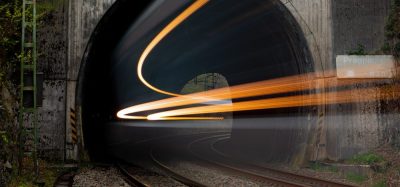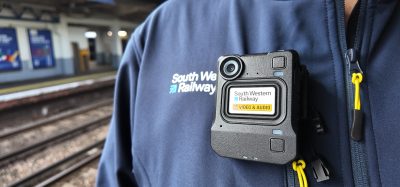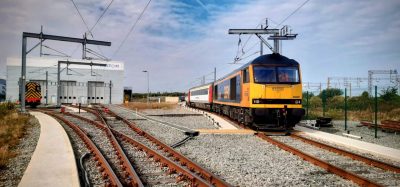Applying the brakes to catastrophic rail freight disasters
Posted: 29 January 2008 | | No comments yet
The possibility of catastrophe always has to be borne in mind in the case of a train carrying hazardous cargo. The risk can be substantially reduced with the use of derailment detectors, which are designed to immediately apply the brakes if a fault is detected.
The possibility of catastrophe always has to be borne in mind in the case of a train carrying hazardous cargo. The risk can be substantially reduced with the use of derailment detectors, which are designed to immediately apply the brakes if a fault is detected.
The possibility of catastrophe always has to be borne in mind in the case of a train carrying hazardous cargo. The risk can be substantially reduced with the use of derailment detectors, which are designed to immediately apply the brakes if a fault is detected.
Although it is impossible in most cases to prevent a rail vehicle from derailing, at least the damage can be minimised by ensuring that the train comes to a complete halt as soon as possible after a derailment. A risk assessment of the Swiss rail network has revealed that some 80% of accidents resulting in major spillage of dangerous goods are caused by derailment. In approximately 40% of all cases, the train driver is not initially aware that there has been a derailment. The situation in Switzerland peaked in the early 1990s when a number of serious accidents occurred involving tank wagons carrying hazardous cargo.
The first was at Stein-Säckingen in 1991 and involved eight tank wagons. The second, at Zürich-Affoltern in March 1994, affected only five tank wagons out of a complete block train, but the results were far more serious. The first wagon to derail was dragged along for more than 2,000m, causing four more to derail at Affoltern station. Escaping fuel caught fire, also setting nearby buildings on fire, and it took five days to extinguish the blaze. As a result, six people were injured and damage amounted to CHF 35 million. This was followed a few months later by another derailment in Lausanne involving 14 tank wagons.
The project
Obviously, the damage – not to mention the disturbance to railway schedules – could have been considerably reduced if the derailment had been detected and the brakes applied a good deal sooner. SBB Cargo, together with the Swiss Federal Transport Authority (BAV), decided the time had come to take action, and spent the next few years working out a plan. In 1999, four parties reached a joint agreement to launch a project for developing and testing pneumatic derailment detectors on tank cars, under BAV’s auspices. The other three partners were SBB Cargo itself, the Swiss Association of Private Wagons owners (VAP), and Oerlikon-Knorr Eisenbahntechnik AG. VAP provided the wagons for the trials (most tankwagons are privately owned in this country). Oerlikon-Knorr provided the technology for developing the new, improved detector on the basis of a prototype model. It is, incidentally, still the only manufacturer to produce such a device. SBB Cargo was to carry out the field trials and funding was provided by a special internal fund that existed at that time for hazardous goods.
Five main factors determined the design of the new derailment detector. Since freight cars are essentially unsophisticated pieces of equipment, the technical concept had to be robust and uncomplicated. It had to be highly reliable and any derailment had to be detected rapidly. The investment and operating costs had to be kept as low as possible. The final requirement was that there should be international homologation through the UIC to facilitate universal application of the device.
Three years later, in 2002, a further step was taken with a joint declaration for the reduction of risks in transporting hazardous cargo in Switzerland. The parties to this agreement were the Swiss Chemical Industries Association (SGCI), SBB Cargo, and the Swiss Federal Department for the Environment, Transport, Energy and Communications (UVEK). It was at this point that the project entered a concrete phase, as one of the provisions of the declaration was the fitting of a number of tank cars with derailment detectors.
By June 2003, 623 tank cars were equipped with the derailment detector EDT 100 developed by Oerlikon-Knorr. Detectors are fitted to the buffer bars, one at each end of the wagon, and connected by a hose or pipe to the central pneumatic braking system. They function by measuring the vertical acceleration, with the brakes being triggered by excessive vibration following derailment of the wagon.
However, in the initial phase there were far too many false alarms, with trains stopping for no apparent reason, usually causing delays and stoppages of at least 20 minutes and sometimes causing disturbance of services for up to five hours. There can be many reasons why this should happen, and although drivers had been given information on EDT 100, it was usually some time before they realised that was the cause of the stoppage. In 2003/04, analysis of monthly temperatures in Basel revealed a correlation between frequency of false alarms and high temperatures in the summer months.
In May 2004, a significant modification was made to the valve seating, and the trials continued. In the months that followed, however, false alarms became even more frequent, and a plan to fit another 1,000 tank wagons with the detectors was postponed indefinitely.
By September 2004, it was possible to solve the problem. As a result of measurements taken on a block train between Glattbrugg and Kork, Oerlikon-Knorr worked out a new tripping value, since it had become clear that the setting of the device was too sensitive for the normal rates of acceleration that apply today. The tripping value was therefore set at 6.5g – 11.5g instead of 5g – 10g, i.e. 9.0 plus or minus 2.5g instead of 7.5g plus or minus 2.5g.
From April 2006, 100 detectors on 50 wagons were re-set to this value, and trials were resumed. Since that time, over 18 months ago, there has not been a single case of a false alarm.
If any further proof of the need for derailment detectors were still required, it soon came in the form of another derailment, this time at Mühlehorn station (St Gallen) in August 2006. None of the wagons on the train were fitted with derailment detectors. An axle broke on the fourth from last tank car, but the train continued, without braking, for another 1100 m, also passing through a set of points. The brakes were finally applied when the last three wagons parted company with the rest of the train on derailing at a level crossing, and tipped over on to the station platform. By great good luck, there were no passengers on the platform, the wagons failed to hit any of the catenary posts, they did not block the parallel track and none of them contained flammable cargo. Nonetheless, the cost in terms of damage to platform, track, overhead wires and the signalling system still came to over CHF 1.5 million, and the route was totally blocked to all traffic for two days.
The results
The contrast between this incident and the case of another derailment at Cornaux (Neuchatel) a few months before, in March 2006, could scarcely be greater. A train pulling 20 tank cars on a passing line at Cornaux station was stopped immediately by the EDT device when four cars derailed on account of rotten sleepers that had caused the rails to pull apart. One wagon was left leaning at a dangerous angle but did not actually tip over, while the other three were merely tilted.
Many lessons on damage limitation can be drawn from this incident. Thanks to the rapid braking action, the derailed wagons were prevented from tipping over completely, leaving the parallel track unscathed. Damage to the wagons themselves was comparatively minor, with the result that no hazardous liquid escaped, thus reducing the risk of an explosion and avoiding large-scale contamination of the ground. The derailment of more wagons was avoided, and it was possible to prevent additional damage to the rail infrastructure despite the broken track. Moreover, the train was stopped before arriving at the station platform, again in contrast to the incident at Mühlehorn.
To satisfy those who were still sceptical about the effectiveness of the device, a demonstration was arranged on some disused tracks at Berlin-Schöneweide in October 2007. The demonstration train consisted of a locomotive and three tank cars, and was run twice, once empty and the second time loaded with 50,000 l of water. The demonstration provided a dramatic example of how effective the use of EDT can be in containing collateral damage caused by the derailment of a fully loaded tank wagon, despite broken rails and bogies.
From its experience in using pneumatic derailment detectors, SBB Cargo has drawn a number of conclusions. Firstly, the relatively uncomplicated technical concept and application of EDT has definitely proved itself in practice. As a result of the re-calibration to the higher value of 6.5 to 11.5 g, no false alarms have been recorded in extensive field trials for a period of over a year. Moreover, the use of EDT can help to substantially limit damage in the case of derailment, as shown by the Cornaux incident.
On the basis of these findings, SBB Cargo is convinced that EDT should become part of the vehicle specification and an essential condition for wagon licensing. For in contrast to other variants, such as the electronic derailment detector not yet developed, the pneumatic version offers a relatively low-cost, robust, fully tested solution to the problem of damage limitation, considerably increasing the chances of keeping people, animals, property and the environment safe in the case of an accident.
Although electronic derailment detectors could well be employed in the future, the conditions for their use are more sophisticated. A source of electric power on the wagon would naturally be needed, as well as cabling and a connection to the main air system. The electronic components would have to be housed in a protective casing, and a data transmission system would probably be desirable. Electronic detectors could make sense for example on wagons that are equipped with GPS or a power supply, such as refrigerated cars, or wagons that are fitted with monitoring or diagnostic systems.
The authorities
The EDT 100 pneumatic derailment detector developed by Oerlikon-Knorr was licensed by the UIC Study Group 5 (Braking and Running Gear) at an early stage in the project. On the basis of BAV’s recommendation and SBB Cargo’s trials, this group decided at its meeting in January 2007 to confirm its approval of EDT 100 with certain modifications. One of these was that the newly calibrated model should have a new name: it is now dubbed EDT 101. The changed threshold values are being adopted and will be published on the UIC website. Type EDT 100 is to be deleted from UIC data sheet 541-08, and all EDT 100 units have to be changed to EDT 101. As a result, all the remaining EDT 100 detectors on wagons operating in Switzerland are to be modified to EDT 101 by July 2011; any that have not been modified by that date will no longer be valid.
While interest in the pneumatic derailment detector and its advantages has been encouraging, the price-tag of several thousand Swiss francs for equipping an existing freight car with EDT 101 could be perceived as a deterrent by cost-conscious companies in other countries. But once the detector is in serial production and being fitted as standard on a new car, the additional amount for including this device would come to below a thousand Swiss francs, i.e. a relatively insignificant amount in relation to the total cost of the car.
Whether, or how soon, derailment detectors will become obligatory for tank cars carrying hazardous cargo is not yet clear. A start has been made: discussions have been held by the RID Committee of Experts on the Transport of Dangerous Goods on whether to make the fitting of derailment detectors obligatory for certain categories of dangerous goods. At its meeting on November 21, 2007 in Zagreb, it drafted a document on the Europe-wide introduction of such detectors from 2011 onwards; assuming no concrete objections are raised and upheld, the installation of derailment detectors could become reality in four years’ time.
About the author
Christian Aubry
Mr. Christian Aubry holds a degree in Mechanical Engineering with a focus on rail vehicle technology from the University of Hanover. Since 2005, he has been Project Manager for Freight Wagon Engineering in the Department of Rolling Stock at SBB Cargo AG in Basel, Switzerland. In his 20-year career his previous job titles include Project Manager, Development and Sales Engineer and Proposal Manager, starting at MAN-GHH Schienenverkehrstechnik in Nuremberg, which later became ADtranz and afterwards Bombardier Transportation in Mannheim and Zurich Oerlikon.
Stay Connected with Global Railway Review — Subscribe for Free!
Get exclusive access to the latest rail industry insights from Global Railway Review — all tailored to your interests.
✅ Expert-Led Webinars – Gain insights from global industry leaders
✅ Weekly News & Reports – Rail project updates, thought leadership, and exclusive interviews
✅ Partner Innovations – Discover cutting-edge rail technologies
✅ Print/Digital Magazine – Enjoy two in-depth issues per year, packed with expert content
Choose the updates that matter most to you. Sign up now to stay informed, inspired, and connected — all for free!
Thank you for being part of our community. Let’s keep shaping the future of rail together!








